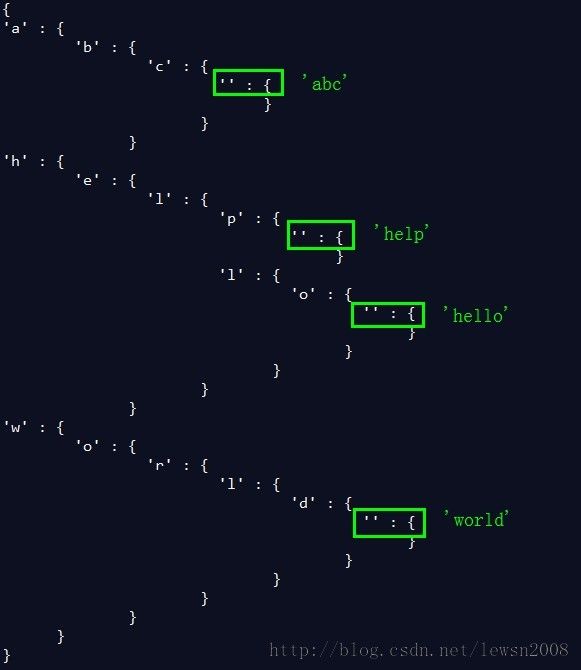Trie原理、扩展及Python实现
关于Trie树的原理这里不做介绍,网上相关的资料非常多,可以参考July的文章:http://blog.csdn.net/v_july_v/article/details/6897097。不过Trie确实是非常的强大,原理不复杂,使用起来也非常的方便。代码实现其实也不难,如果用C++实现的话需要自己定义数据结构(结构体)来构建树,这里我介绍怎样用Python实现,用Python实现起来尤为的方便,不用自己定义数据结构,用Python的dictionary类型即可。说一句题外话:我发现自从学会用Python以后就爱不释手,确实是使用起来非常方便。言归正传,看看Python实现的简易Trie树,为什么说是简易呢?因为没有实现复杂的功能,只是为了说明Trie的基本原理,而且只支持ascii字符。实现了以下几项基本功能:
1、添加单词:LBTrie的add方法;
2、查找单词:LBTrie的search方法;
3、打印Trie树:LBTrie的output方法。
class LBTrie:
"""
simple implemention of Trie in Python by authon liubing, which is not
perfect but just to illustrate the basis and principle of Trie.
"""
def __init__(self):
self.trie = {}
self.size = 0
#添加单词
def add(self, word):
p = self.trie
word = word.strip()
for c in word:
if not c in p:
p[c] = {}
p = p[c]
if word != '':
#在单词末尾处添加键值''作为标记,即只要某个字符的字典中含有''键即为单词结尾
p[''] = ''
#查询单词
def search(self, word):
p = self.trie
word = word.lstrip()
for c in word:
if not c in p:
return False
p = p[c]
#判断单词结束标记''
if '' in p:
return True
return False
#打印Trie树的接口
def output(self):
print '{'
self.__print_item(self.trie)
print '}'
#实现Trie树打印的私有递归函数,indent控制缩进
def __print_item(self, p, indent=0):
if p:
ind = '' + '\t' * indent
for key in p.keys():
label = "'%s' : " % key
print ind + label + '{'
self.__print_item(p[key], indent+1)
print ind + ' '*len(label) + '}'
if __name__ == '__main__':
trie_obj = LBTrie()
#添加单词
trie_obj.add('hello')
trie_obj.add('help')
trie_obj.add('world')
trie_obj.add('abc')
#打印构建的Trie树
trie_obj.output()
#查找单词
if trie_obj.search('hello'):
print 'Yes'
else:
print 'No'
if trie_obj.search('China'):
print 'Yes'
else:
print 'No'
打印的Trie树如下图所示:
查找输出结果为:
Yes
No
【扩展】
1. Trie树的应用之一:搜索引擎的Suggestion,文章中有介绍:http://blog.csdn.net/stormbjm/article/details/12752317
2. 1中的文章讲了基于Trie树的搜索引擎Suggestion,同时推荐了基于另外一种数据结构的Suggestion:一种基于Trie变种的数据结构——三叉树(Ternary Tree),见文章:http://igoro.com/archive/efficient-auto-complete-with-a-ternary-search-tree/,文章讲到:三叉树比Trie有更高的存储效率。
